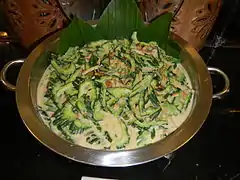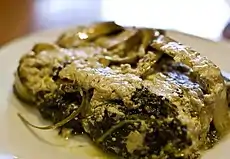Ginataan
Ginataan, alternatively spelled guinataan, is a Filipino term which refers to food cooked with gatâ (coconut milk).[1] Literally translated, ginataan means "done with coconut milk". Due to the general nature of the term, it can refer to a number of different dishes, each called ginataan, but distinct from one another.
_-_Philippines.jpg.webp) .jpg.webp) Top: Ginataang kalabasa (calabaza and string beans in coconut milk) with shrimp; Bottom: Ginataang mais, a dessert rice gruel (lugaw) with sweet corn and coconut milk | |
| Course | Main course, dessert |
|---|---|
| Place of origin | Philippines |
| Serving temperature | Hot or cold |
| Main ingredients | Coconut milk (gatâ) |
Terminology
Ginataan usually refers to dishes which are eaten with rice during the major meals of the day. It normally follows the form "ginataan na/ginataang + (whatever it is cooked with)" or "(dish name) + sa gatâ". For example, ginataang hipon refers to shrimp cooked in coconut milk, ginataang gulay to an assortment of vegetables cooked in coconut milk, ginataang alimango is mud crabs cooked in coconut milk, while ginataang manok is chicken cooked in coconut milk.[2][3][4] Coconut milk can also be added to existing dishes, as in ginataang adobo (known more commonly in Tagalog as adobo sa gatâ).[5]
There are other dishes that are known by their own unique names, such as Bicol Express, laing and variants of pinakbet, which nonetheless fall under the ginataan category because they use coconut milk as one of the main ingredients.[6][7]
Sweet variants
Various sweet desserts may also simply be called ginataan, especially in the northern Philippines.[1] For example, the Visayan binignit, a soup made with coconut milk, glutinous rice, tubers, tapioca pearls, and sago is simply called ginataan in Tagalog (a shortened form of the proper name, ginataang halo-halo).[8] This soup is also called "giná-tan" in Bikolano, "ginettaán" in Ilokano, and "ginat-ang lugaw" in Hiligaynon. If gummy balls made of pounded glutinous rice are used instead of plain glutinous rice, it becomes a dish called ginataang bilo-bilo or simply bilo-bilo.[9] Ginataang mais is another example of a dessert soup; a warm, sweet, thick gruel made with coconut milk, sweet corn and glutinous rice.[10]
List of ginataan dishes
Dishes considered under the ginataan category include the following:
Main dishes

.jpg.webp)
- Adobo sa gata
- Curacha Alavar
- Ginataang ampalaya
- Ginataang isda
- Ginataang kalabasa
- Ginataang kuhol
- Ginataang labong
- Ginataang langka
- Ginataang manok
- Ginataang ubod
- Ginisang munggo sa gata
- Gising-gising (Ginataang sigarilyas)
- Inubarang manok
- Inulukan
- Kinilaw
- Laing
- Linarang
- Piaparan
- Pininyahang hipon
- Pininyahang manok
- Piyanggang manok
- Sinanglay
- Sinantolan
- Sinilihan (Bicol Express)
- Sorol
- Tinumok
- Tiyula itum
Dessert
References
- "Spanish Influence on Filipino Food". Archived from the original on 2007-02-14. Retrieved 2009-03-20.
- Myke Sarthou (2014). Angelo Comsti (ed.). The Filipino Family Cookbook: Recipes and Stories From Our Home Kitchen. Marshall Cavendish International Asia Pte Ltd. p. 92. ISBN 9789814634946.
- IBP, ed. (2007). Philippines Country Study Guide. International Business Publications. p. 112. ISBN 9781433039706.
- Linda Civitello (2007). Cuisine and Culture: A History of Food and People. John Wiley & Sons. p. 240. ISBN 9780471741725.
- "Adobo sa Gata". Kawaling Pinoy. 5 November 2013. Retrieved 3 January 2015.
- "Bicol Express Recipe". Panlasang Pinoy. Retrieved 3 January 2015.
- "Pinakbet with Gata (Vegetables Cooked with Coconut Milk)". Food Batangas. Retrieved 3 January 2015.
- "Foods to Have During the Holy Week: BINIGNIT". Essshiii Food Blog. 16 April 2014. Archived from the original on 3 January 2015. Retrieved 3 January 2015.
- "Ginataang Bilo-Bilo (Sticky Rice Balls in Coconut milk)". Pinoy Cooking Recipes. Archived from the original on 3 January 2015. Retrieved 3 January 2015.
- "Ginataang Mais (Corn in Coco Milk)". Food.com. 2 March 2013. Retrieved 3 January 2015.

